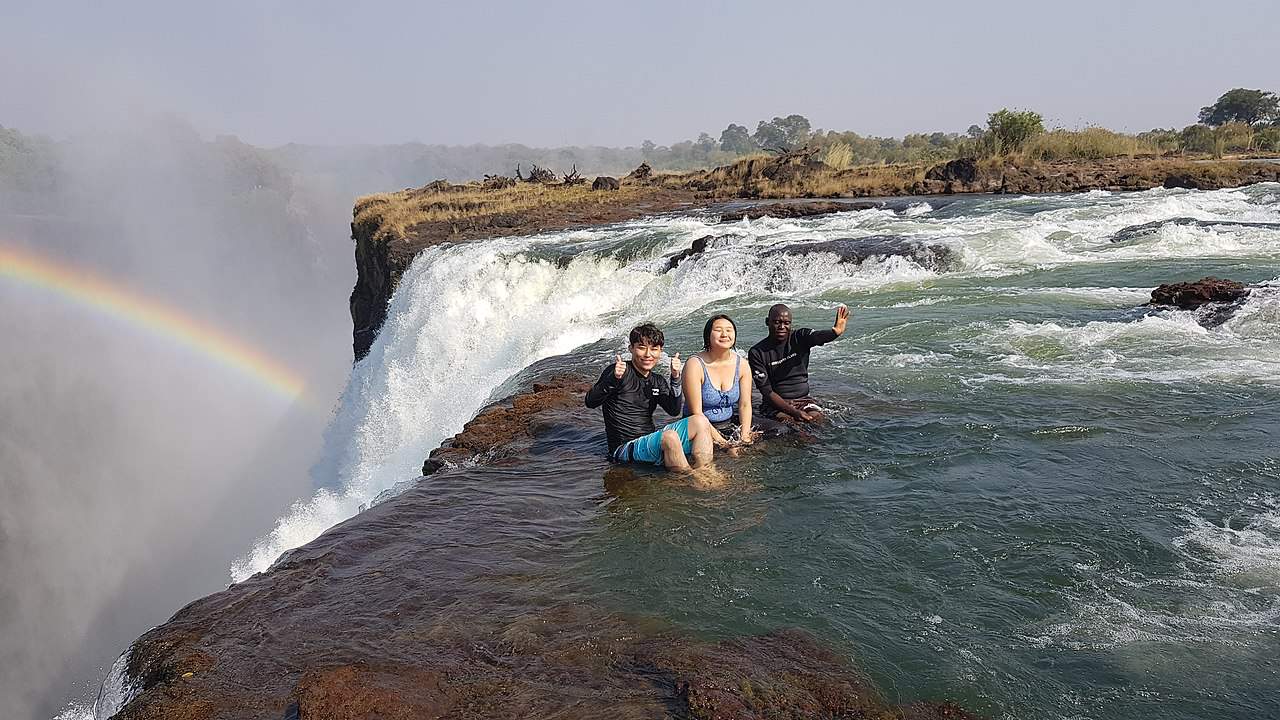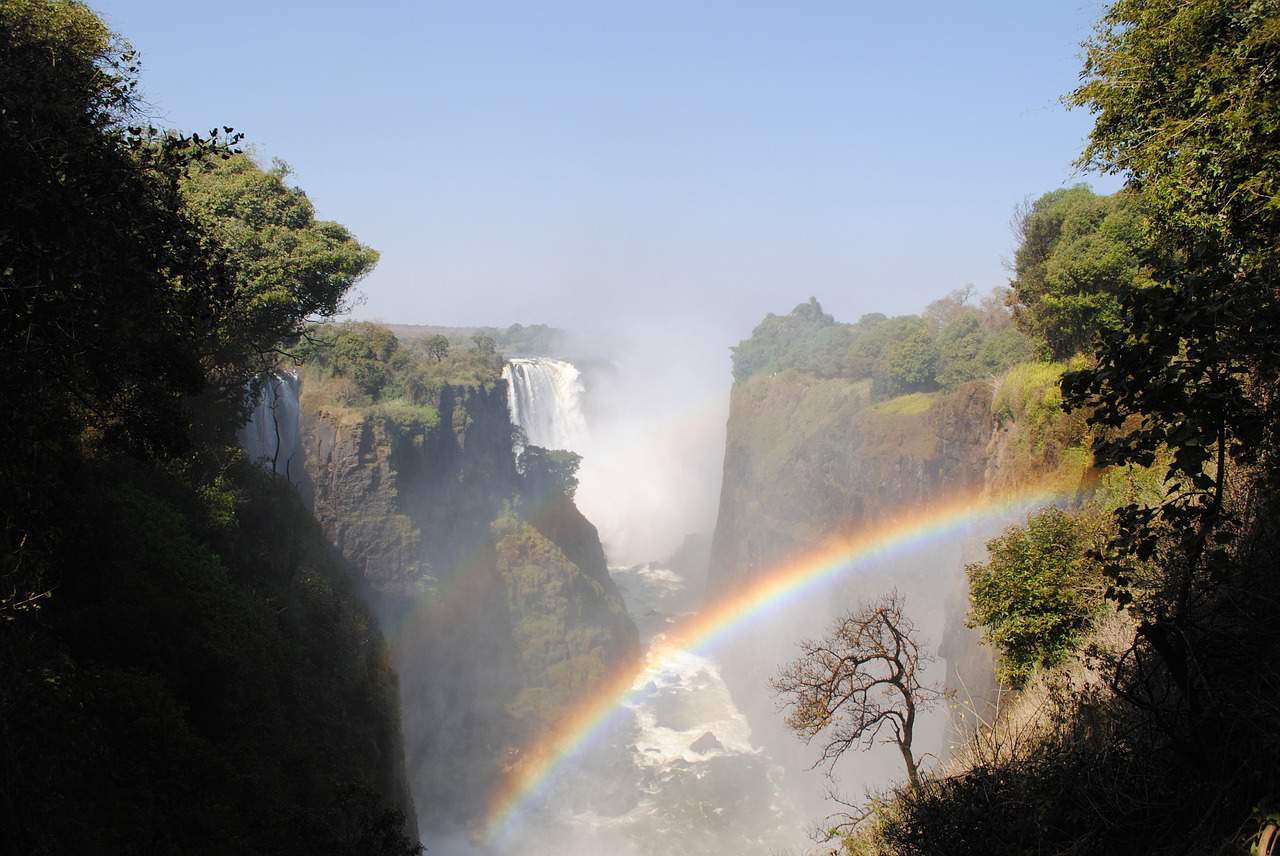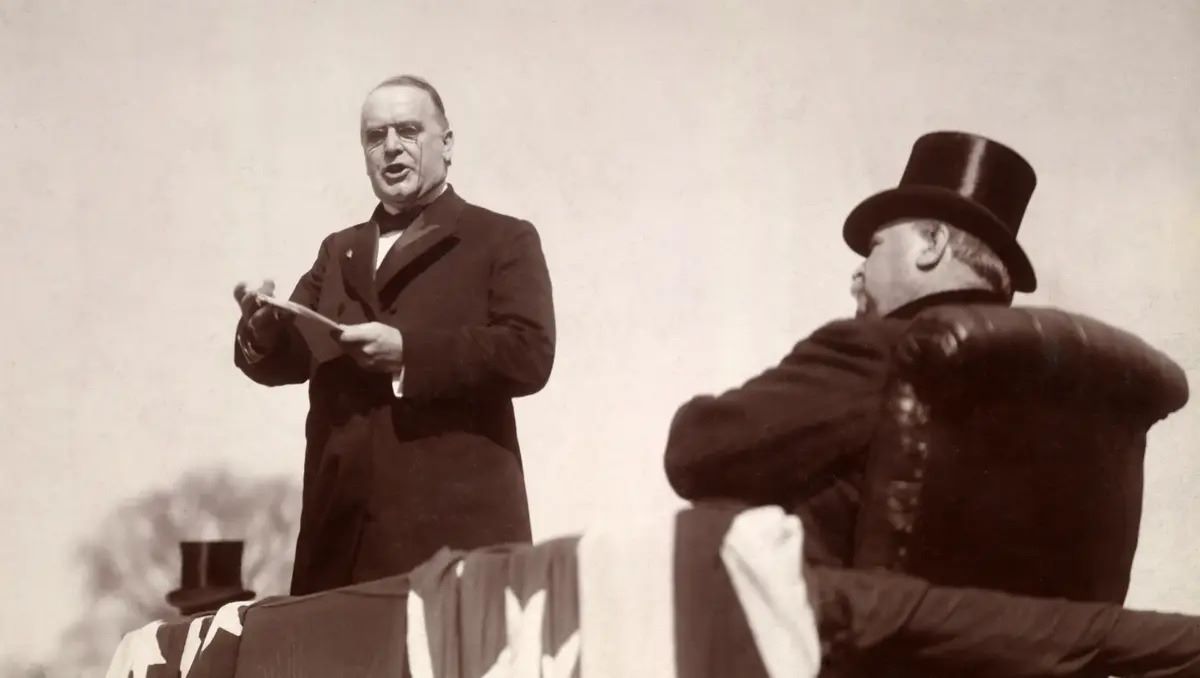
The Victoria Falls is a giant waterfall that is more than 1 kilometer in length. Its spray or mist can rise into the air to a height of about 500 meters. One can see the spray from 30 kilometers away. No wonder why it’s one of the earth‘s most valuable treasures, and millions of people have been visiting it to see its beauty! In fact, German travel magazine Geo Fernweh, calls it one of the best tourist destinations in the world. They are definitely not wrong — for more than 100,000 years, tourists from around the world visit Victoria Falls to see the cascading falls up close. It is one of the most picturesque places in the world. A haven for people who want to see and experience the beauty of nature.
Fitting for a landmark of this magnitude, there are many ways to see the falls. Thrill-seekers tackle the raging white-water currents on a rafting adventure. Some ride a helicopter on a sightseeing flight, while some even swing through the mist on a bungee jump!
Looking for a more relaxing way to enjoy the falls? Other tourists go on canoe safaris and sunset cruises that offer spectacular views of the wildlife. If you’re looking for a true taste of African culture, you can book an experience with a local family to have a traditional African lunch in their home.
Want to know more about what is perhaps the most famous waterfall in existence? Then go and check out our compilation of top 50 rapid-flowing Victoria Falls facts. You will be even more in awe of this beautiful place once you’re finished with our comprehensive and curated collection of Victoria Falls facts and trivia! Who knows? It might even inspire you to see the falls for yourself!
- Victoria Falls measures 1,708 m or 5,604 ft wide.
- Victoria Falls stands at 108 m (354 ft).
- The Zambezi is Africa’s 4th longest river in Africa and the largest flowing river into the Indian Ocean from Africa.
- Victoria Falls can drop more than 500 million liters of water per minute.
- Approximately 1 million people visit Victoria Falls each year.
- Victoria Falls is located in the Zambezi River in Southern Africa.
- Its local nickname is “Mosi-oa-Tunya” or ‘The Smoke That Thunders.”
- Shungu Namutitima or “Boiling Water” is its other nickname.
- Victoria Falls provides a habitat for unique species of plants.
- The Victoria Falls Rainforest is filled with ferns, creepers, flowers, liana vines, date palm groves, fig trees, and mahogany.
- Victoria Falls is on the border of Zambia and Zimbabwe.
- Victoria Falls is one of the world’s largest waterfalls.
- Victoria Falls is part of the watercourse of the Zambezi River.
- Although it’s not the highest or the widest falls, Victoria Falls produces the world’s largest sheet of falling water.
- Victoria Falls is about twice the height of Niagara Falls.
- Most tourists go to Zambia and Zimbabwe to see Victoria Falls.
- The area around Victoria Falls is generally considered safe.
- It “rains all day” within Victoria Fall’s perimeter. As the spray from the falls rises, the small droplets condense and fall making it look like it’s raining.
- Victoria Falls is a cataract waterfall. A cataract waterfall contains great volumes of water rushing over a precipice or a very steep rock face.
- Victoria Falls is not the highest nor the widest waterfall in the world.
Most of the trails going to the falls are on the Zambian side.
Although most of its trails are on the Zambian side, ironically, this side will only let you see up to 30% of Victoria Falls. Meanwhile, the trails on the Zimbabwe side will allow you to see roughly 80% of the falls.
February to May are its best months.
February, March, April, and May are the months where Victoria Falls is at its best. During these months, visitors can enjoy the world’s largest sheet of falling water splashing at its greatest volume.
Victoria Falls was first known in 1855.

David Livingstone discovered the Victoria Falls in 1855. He is a Scottish physician and an explorer in Africa. To have a better view of the falls, Livingstone stood in a small land at the edge of Victoria Falls. This small parcel of land is now known as the Livingstone Island.
Livingstone Island is one of the best vantage points.
Livingstone Island sits on the edge of Victoria Falls in the very midst of its roaring waters. Above all, Livingstone Island is one of the best vantage points in witnessing Victoria Fall’s natural beauty.
Victoria Falls exists because of the Zambezi River.
The 2,574 km long Zambezi River, the fourth-longest river in Africa, outpours its water to Victoria Falls. The water continues to flow to several border countries such as Namibia, Botswana, and Mozambique. It finally ends in the Indian Ocean.
The Devil's Pool is another attraction at Victoria Falls.

The Devil’s Pool is near the edge of the falls in the western point of Livingstone Island on the Zimbabwean side. Courageous visitors can literally swim, despite the risk of plunging over the edge, in this “natural pool” sitting at the edge of Victoria Falls.
Devil's Pool is open depending on Zambezi River's water levels.
Devil’s Pool is open from 7:30 a.m. to 5 p.m. usually between mid-August and mid-January. During these months, the Zambezi River’s water levels are low enough for swimmers to experience and enjoy the natural pool.
Swimming at the Devil's Pool is generally safe.
Swimming at the Devil’s Pool is generally safe provided you follow its safety guidelines. The Devil’s Pool has a rock lip protruding upwards and keeps its visitors from falling over the edge.
Wang Shunxue is a Victoria Falls survivor.
In November 2013, Wang Shunxue from China became part of the news headlines in both international and local media after he slipped and fell into Victoria Falls. Fortunately, the man survived. Every year or two, at least one tourist dies after falling into Victoria Falls.
The Zambezi River's water levels are high from December to April.
The Zambezi River generally has high water levels from early December until April because of the rainy season. From February to May, the fall’s spray can rise to a height of more than 400 meters or 1,300 feet which is amazingly visible from up to 48 kilometers or 30 miles away.
Victoria Falls can create a moonbow.
When there is a full moon, the famous “moonbow” appears in Victoria Falls. Without getting into too much science, a moonbow or lunar rainbow is a series of rainbows that can be seen at night in the spray of Victoria Falls. This wonder is at its greatest during high-water, usually from April to July where there is none to very few clouds in the sky.
Victoria Falls is suffering from the worst drought in a century.
Victoria Falls’ water flow normally declines during the dry season. According to reports, a recent drought has scoured the region in the past years, further reducing its water flow to the lowest level in 25 years.
Victoria Fall's dry season reveals more islets.

When Victoria Fall’s dry comes into play, its islets on the crest become more numerous and wider. At least half of the rocky face of the falls may become dry from September to January and the bottom of the First Gorge can be seen along most of its length.
There are six individual gorges in Victoria Falls.
Victoria Falls has six gorges. The First Gorge measures 100 m. While the second gorge is the “Boiling Pot” located under Victoria Falls. It measures two kilometers long. Victoria Fall’s hydroelectric power station is located in the Third Gorge. This gorge measures around two kilometers long. The third, fourth, and fifth gorges are the longest of the six.
The Songwe Gorge is the longest amongst the six gorges.
The Songwe is the sixth gorge of Victoria Falls which measures 3.3 kilometers. Its name came from Songwe River which is around five kilometers away from Victoria Falls. The Fifth Gorge measures 3.2 kilometers, and the Fourth Gorge is more than two kilometers.
This article belongs to Facts.net and may not be reproduced, copied, edited, published, transmitted, or uploaded in any way without the permission of Facts.net.
The Victoria Falls National Park has an area of 23.4 sq. km.
The Victoria Falls National Park is located in the North-Western Zimbabwe called the Hwange District. It has an area of 23.4 square kilometers or 2,340 hectares. Within the National Park is the rainforest growing in the spray of Victoria Falls. It also supports numerous species of plants.
Victoria Falls National Park supports diverse wildlife.

Visitors or tourists of Victoria Falls National Park have an opportunity to spot different species of animals here such as the Cape buffalo, hippopotamus, antelope, elephant, southern white rhinoceros, and eland.
Accommodation is available in Zambezi National Park.
Accommodation or lodging is also offered in Zambezi National Park. The national park, located upstream from Victoria Falls, has several resorts and hotels in and throughout the town of Victoria Falls. However, it’s important to take precautionary measures against malaria for the area is also known for it.
The Zambezi River has a great population of crocodiles.
The Zambezi River has a great population of crocodiles. If you go for a boat cruise going to Victoria Falls, chances are you’ll see many of them. There is a variation of boats to choose from for the boat cruise. A fine standard sunset cruise costs start at around $40 inclusive of snacks and drinks.
Victoria Falls is home to various birds of prey.
Victoria Falls has numerous birds of prey nest on the rocks of its gorges including the Verreaux’s eagle (a large African bird of prey), Taita falcon (a small falcon mostly found in central and eastern Africa), Augur buzzard (a fairly large African bird of prey), and the Peregrine falcon (the fastest bird on earth which can fly at a speed of 390 km/h).
Victoria Falls is home to various aquatic species.
Victoria Falls is likewise home to various aquatic species with over 35 species of fish in the Zambezi River alone. In the upstream part of the falls, there are over 80 species. Some of the fish species you can find in the river are the African Pike, Upper Zambezi yellowfish, bream, and barbel.
Victoria Falls Airport is crucial to Zimbabwe's tourism industry.
The Victoria Falls Airport is an international airport that serves a major role in its tourism industry. Located 18 kilometers south of the town of Victoria Falls, Zimbabwe, it caters to more than 1.5 million passengers annually. The Victoria Falls Airport is open 12 hours per day with customs and immigration services and other facilities and services such as restaurants, duty-free shops, weather information, cargo, and passenger handling.
Victoria Falls Bridge connects Zambia and Zimbabwe.

Built over the Second Gorge of the falls, the beautiful Victoria Falls Bridge crosses the Zambezi River just right beneath the falls. Accordingly, the bridge links the two countries (Zambia and Zimbabwe) with its border posts on both ends.
The Victoria Falls Bridge was made in England.
The Victoria Falls Bridge’s length is 198 meters (or 650 feet) and has a height of 128 meters or 420 feet. The Cleveland Bridge & Engineering Company fabricated the bridge in England initially before it was shipped to Victoria Falls. It took 14 months to construct the Victoria Falls Bridge and was finally completed in 1905 which made it accessible for foot and road traffic.
It's best to stay on the main trail of Victoria Falls Rainforest.
When you are at Victoria Falls Rainforest, it’s always best to stay on the main paths at all times. The rainforest walk can be very damp and slippery at certain months of the year so make sure to keep yourself ready by wearing appropriate hiking shoes. Wear the appropriate hiking outfit as well to keep your belongings dry. Above all, respect wildlife by avoiding making too much noise and getting close to them.
The Victoria Falls Rainforest is a protected area.
According to the rules and regulations of the Victoria Falls Rainforest, it does not allow its visitors to take samples of the plants anywhere along the Victoria Falls walk. It’s also prohibited to use drones, feed wild animals, and crossing the barriers along the rainforest walk. The authorities are doing their best to protect the area and visitors must respect its guidelines. But, cheer up! You may take as many photos as you like.
There is a planned Hydroelectric Power Station in Batoka Gorge.
The Batoka Gorge Hydroelectric Power Station plan is a 3.2 million mechanical horsepower or 2,400 megawatt hydroelectric power station. The said project is on the Zambezi River across the international border between Zimbabwe and Zambia. It will sit on the Zambezi River, roughly 54 kilometers or 34 miles downstream of Victoria Falls.
The Hydroelectric Power Station will be Africa's largest hydropower dam.
The Zimbabwean and Zambian governments have been planning the Batoka Gorge Hydroelectric Power Station for over 70 years now. It will be Africa’s largest hydropower dam once it’s completed. As of its latest update, the project costs around $4.5 billion, and General Electric Africa is one of the interested developers in this power station.
Victoria Falls is one of the Seven Natural Wonders of the World.

In 1997, Victoria Falls became one of the Seven Natural Wonders of the World. This organization supports and preserves all the natural wonders across the globe. CNN has chosen the magnificent falls and its tranquil lagoons. The rest of the natural wonders of the world includes Parícutin, Mount Everest, Harbour of Rio de Janeiro, Great Barrier Reef, Aurora Borealis, and Grand Canyon.
Victoria Falls Became a World Heritage Site in 1989.
Victoria Falls became a UNESCO World Heritage Site in 1989. When a landmark or area is declared a World Heritage Site it means that is judged to contain “cultural and natural heritage around the world considered to be of outstanding value to humanity”.
Was this page helpful?
Our commitment to delivering trustworthy and engaging content is at the heart of what we do. Each fact on our site is contributed by real users like you, bringing a wealth of diverse insights and information. To ensure the highest standards of accuracy and reliability, our dedicated editors meticulously review each submission. This process guarantees that the facts we share are not only fascinating but also credible. Trust in our commitment to quality and authenticity as you explore and learn with us.


